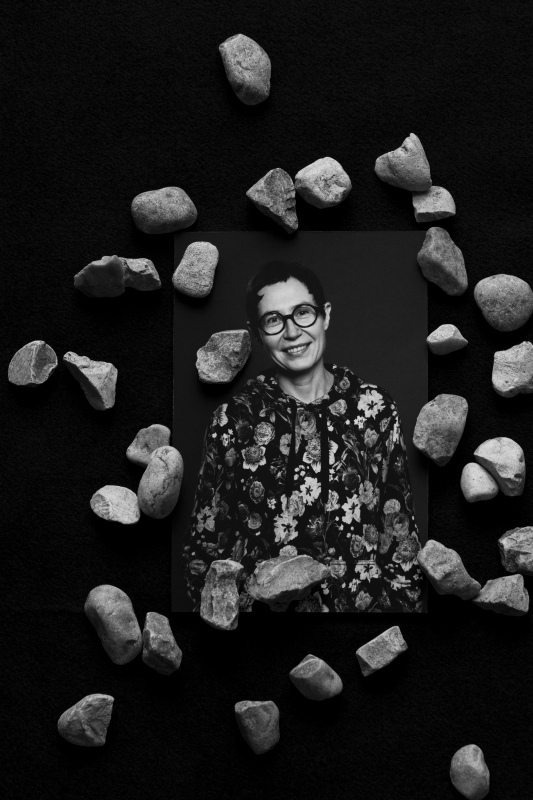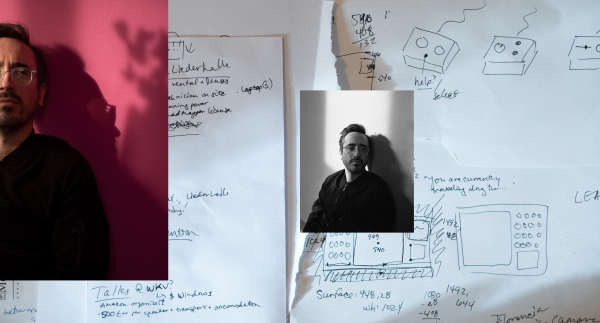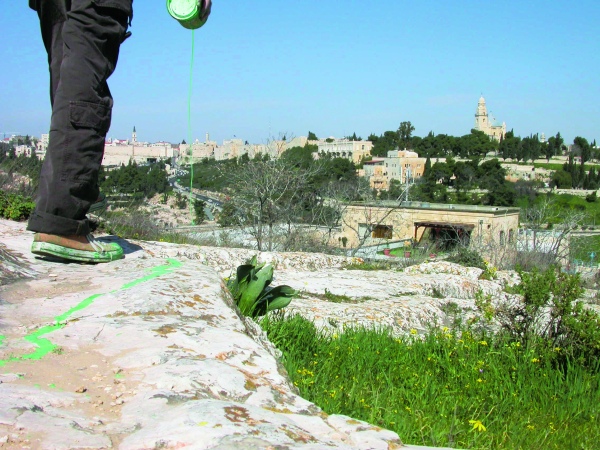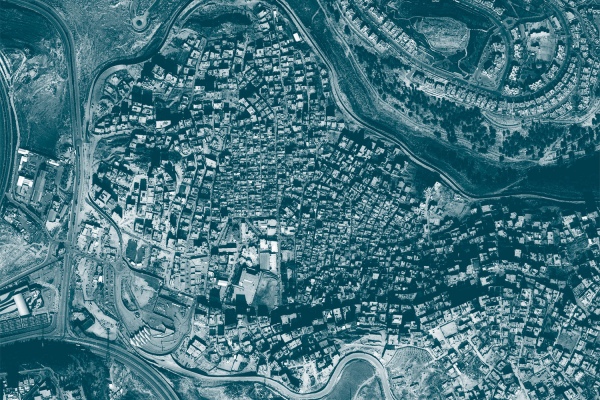A tuning of sensitivity
Joanna Rajkowska in conversation with Bogna Świątkowska
-
Bogna Świątkowska: This wasn’t your first visit to Palestine. You’d been there before, several years earlier, so you have a wide and multidimensional perspective. I’d like us to start our conversation by discussing the notion of resistance. Does it evoke any particular feelings or connotations for you? Perhaps a sense of defiance?
-
Joana Rajkowska: It hurts me to think that you need to keep inventing new strategies of resistance. That after all these years the steel grip of occupation has only tightened. I can’t compare myself to someone who was born in Palestine, grew up there, and constantly got smacked on the head by the Israeli authorities. But I’d like to redirect this tension, this anger and the energy of, well, not so much resistance as aversion, which is how it basically feels now. When you press from above, it exits through the side. And it happened in me too. I felt that I’d like to exit through the side. Escape into the past and possibly into the future. Use an emergency exit. A mix of cultural and environmental themes will be inevitable here, if only because of climate change which brings us all closer in a dramatic way. But which also originates from everyday rituals, whether we want it or not.
-
While in Ramallah, I searched for “extraordinary” ways to cope with reality, ways that combine different themes, and mix climate change with the rituals of daily life.
-
-
As far as I could see, your sensitivity there was recording everything that was happening in the landscape, in the scenery. You were highly receptive to the unspectacular. Why and to what extent is it important for you to divide your attention between things that are intense and those that lack the intensity?
-
I’ve been generally less and less interested in resistance expressed directly, on the political scene. I guess we’ve hit the wall and felt that it’s hard, and that the existing forms of resistance aren’t working. That’s why I’m talking about extraordinary ways. About unspectacular extraordinariness. I admire activists with all my heart, but I guess in my case it’s better to be working in what I call the forefield. To direct my energy, thinking, and attention towards a different kind of intensity. This, perhaps, is a slow-working strategy, but I believe it to be more effective in the long-term. I mean developing a sensitivity before you start acting. Before you even start thinking about acting. Adopting such an orientation towards the world where you activate certain regions not only of your mind, but above all of your body. A tuning of sensitivity. That’s where rituals very often have access. They’re not new, they’re as old as our culture itself, and in some inexplicable way they touch upon the most significant registers of our existence. There they are potent and will forever continue to be. Only then comes the time for reflection, for conclusions to be drawn from rational analysis – when we’ve prepared and tuned ourselves. Then is the time for activism and direct-action strategies. Today our ability to influence reality is extremely limited. This is because as a culture we have stopped to believe in the possibility of working through different channels, we have let them become closed, abandoned, just empty. I inhabit those channels readily.
-
-
The project you did in Ramallah highlighted all what you’ve just said. A meeting with an amateur collector of geological samples brought into focus a collection that is both enduringly present and unspectacular.
-
Yes, it’s fascinating how people inhabit the landscape. Zionism’s greatest misfortune was that the diaspora Jews came, set up the kibbutzim, and started farming the land, which they first should have grown intimate with. They busied themselves cultivating an exploitation-based culture. Of course, there was commitment and enthusiasm to it. I’d have probably been a kibbutznik myself those days. The Palestinians deal differently with the landscape, their relationship with the land is subtler. In 2007, we travelled around Palestine with Artur Żmijewski. He often asked about what should be done. What should be the response, the strategy of resistance. And the replies were all similar: “We’re simply here to stay, we’re not going anywhere.” It was interesting to note that they didn’t answer the question directly, because, of course, no one knows what should be done in a situation of extreme paralysis. They spoke about enduring, about being there. This kind of plant-like approach appealed to me greatly. No one knows what to do with a strategy of vegetative duration. It’s very smart and very dramatic at the same time.
-
-
Geological samples seem very much fitting for a conversation about duration. Tell me about your meeting with the author of a collection exhibited in a small grocery store. It suddenly turns out that in the middle of the chaotic Ramallah you can find an extraordinarily intriguing experimental institution.
-
Well, you can, you can [laughs]. When an artist presents an art object, I always imagine how they made it. What moves they had to perform for the object to come into existence. And here you just know that the guy walks with his eyes on the ground, looking. I’m interested in the relationship people have with the material. Especially if they feel, look, absorb, don’t consider matter solely as a resource, but approach non-man-made creations with great respect, reflecting on their origins, touching them. Alas, there are very few people who wouldn’t be mincing the planet and transforming it into objects of immediate utility. But Mohammad is. And that made me respect him.
-
-
The landscape in Palestine is not only what we see. For a whole lot of people it consists of many levels of imagery, cultural, religious. And suddenly something that is simply a landscape - the land, the trees, the sky, the creatures there – turns into something that signifies and means much more. Do you feel the same way?
-
I’m not into such stuff at all. I see no Promised Land, no God, Honour, or Homeland. Such notions are alien to me. What I see is trash and garbage. Olive trees, buildings growing on the yeast of empty loans, and plastic pipes sticking out from the ground – that’s what I see. The greatest misunderstanding is that I can’t get along with my generation because they think that I’m looking for spiritistic themes. No! That’s not my thing. I just walk with my nose close to the ground; that how I explore the world. I stoop and look down. I have no further visions. But I respect all gestures whereby a complex, multilevel relationship with the material around us is developed. For what else rituals are? The point isn’t for an an apparition to appear on the sky [laughs], or to perform miracles, but to be in, to have a relationship with. To feel your place in the landscape down to your spine. That’s why in my project I used some detailed descriptions by Tawfiq Canaan, who records all Palestinian demons, the grottoes and hills where they dwell, the rituals that connect people with the demons of land and water, with rivers and caves. Those are powerful, virtually tangible material descriptions, which serve as best proof of Palestinians’ organic bond with the land prior to Zionism. And it’s not about just demons, but about the energy that is activated in the process and which overwhelms us, making us one with the soil, the water, the sky. We’ve abandoned these rituals, modernism has castrated them all. We suffer because of their absence, bringing major misfortunes upon our heads.
-
-
Is that why you were so taken with Mohammad Badwan’s shop?
-
Yes. And I learned a lot there. He didn’t like it when I moved those rocks. This appealed to me too. I thought in his case it wasn’t just the gesture of bending down and picking up those rocks, but also of activating the imagination, for he sees all kinds of creatures in them, how they are connected, and then he recreates those connections on the shelves of his shop. Those rocks have an identity. Each has a personality and a description. When we were removing them one by one to take their pictures, Mohammad was agonised. He wanted it, he was very proud about it, but he was also agonised [laughs]. We tried to put them back exactly the same way as they were before, but it was impossible to reproduce the original set-up. At that point I thought that he lived with those views, that he had built himself a landscape. He had built himself a Palestine, recreated it right there in his shop. Those hills and the emotions he felt when climbing them – he had reconstructed it all in downtown Ramallah on uneven steel shelves. He had created for himself a miniature independent autonomous Palestine in his shop. Beautiful!
-
-
Translated by
-
Marcin Wawrzyńczak
-



